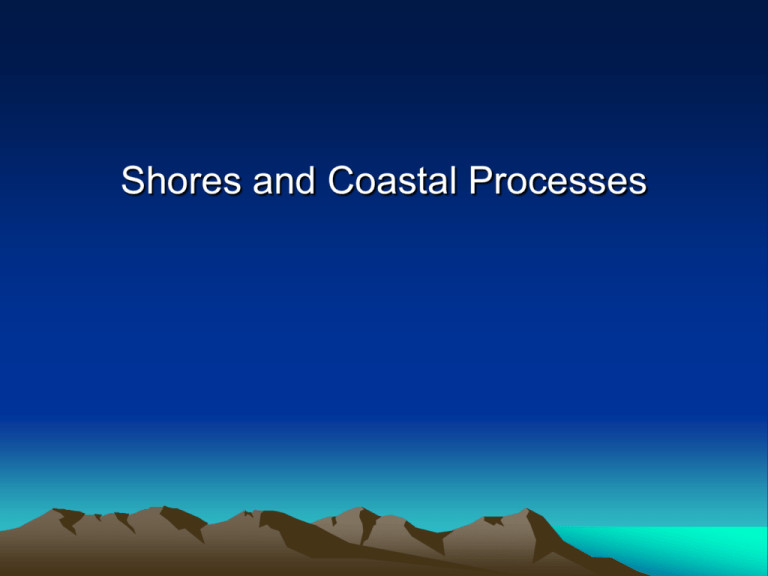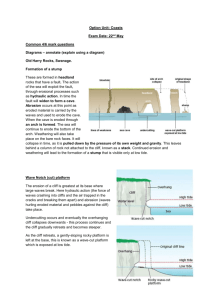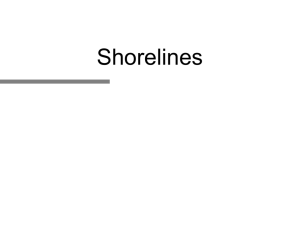Chapter 16 Deserts
advertisement

Shores and Coastal Processes Shores and Coastal Processes • Shorelines are places where bodies of water meet dry land • Coasts are landward of ocean shorelines • Beach: a narrow strip of land, washed by waves or tides . • Ordinary Waves are caused by WIND – Waves are produced when wind drag causes the surface water of oceans/lakes to rise and fall - Waves get refracted on approaching shoreline Typical Coast Waves are caused by _____________? Parts of A Wave Fetch – Southern Ocean, Straits of Magellan Oscillatory and Translatory Motion Translatory motion re-suspends sediment Wave Refraction Still a small ‘longshore component backwash swash Kids at the beach Shores and Coastal Processes • Longshore current is produced as water flows parallel to coastline • Rip Currents are produced when water piles up in surf zones and flows seaward, generally perpendicular to the coast. Longshore Currents (Swash and Backwash) Rip Currents Cut in Bar Sand Bar Sand bars are big ripples storms cut them, causing a rip channel Tides – Mostly the Moon • Daily rise/fall of surfaces of oceans/lakes due to gravitational pull of the Moon/Sun on the Earth– also due to force created as Earth spins on its axis • Flood tides- elevate sea surface that cause shoreline to move inland • Ebb Tides- low sea surface that cause shoreline to move seaward Tidal Bulges Affect of the Sun Much less The Effect of Tides On Shorelines Tides mostly caused by the Moon Large Tidal Extremes • Bay of Fundy tides reach16 m (about 53 ft) at the head of the bay. The 12.4 hour period of the twice daily lunar tides is close to the natural back and forth sloshing period of the bay. The Effect of Tides On Shorelines – River Hebert in Nova Scotia Tidal Bore Anecdote: local tidal bore Source: Clyde H. Smith/Peter Arnold, Inc. Low Tide at Bay of Fundy Source: William E. Ferguson Rising Tide at Bay of Fundy Maximum Source: William E. Ferguson Coastal Erosional Features • Wave erosion occurs when deep water waves hit the shore with full force • Air and water are forced into cracks at high pressure Coastal Erosion (Crashing Surf) Crashing Surf, Oregon Coast Source: Criag Tuttle/The Stock Market Coastal Erosion Source: Paul Sequeira/Photo Researchers, Inc. Lighthouse at Morris Island, SC Source: Donald Carter Coastal Erosion Structures • Headlands- cliffs that jut seaward • Wave-cut bench is produced when waves undercut headland • Sea Caves are produced when waves are refracted against the side of headland • Sea Arch forms when two Sea Caves erode completely through the headland • Sea Stack is formed when Sea Arches collapse Erosional Coastal Landforms Submerged Shallow Area Bends Waves Erosional Coastal Landforms Sea Caves on Cape Kildare, Prince Edward Island, Canada Source: John Elk/Bruce Coleman Deposition of A Tombolo A Tombolo Landward of A Sea Stack – Big Sur, California Source: Cliff Wassmann Coastal Protection • Riprap/Seawall- protect shore lines • Groin – stabilizes beaches • Jetty – keep inlets clear • Breakwater – protect a harbor Beach-Protection Structures - Riprap Source: Jack Dermid /Photo Researchers, Inc. Beach-Protection Structures – Seawall Along the Gulf Coast of Louisiana Source: Martin Miller Groins Groins off Cape May, New Jersey Source: John S. Shelton Jetties Jetty in Miami Beach, Florida Note how it is much narrower than the original inlet. Smaller cross-sectional area therefore higher velocity, more erosion in the new channel, keeps the channel deep. Source: Townsend P. Dickinson Components of A Typical Beach How to tell a berm from a sand dune Small notes for Prof. Smart to repeat previous slides: Beach a narrow strip of land washed by waves or tides Foreshore is the area between low tide and high tide Backshore is the area between high tide and sea cliff or inland vegetation line Beach face is the steepest part of Foreshore Berm is a horizontal bench of storm sediment Volcanic Black Sand Beach Detrital sediments are classified with particle sizes. Sand is a size, not one specific mineral Source: Breck P. Kent Beach sediments usually quartz, but sometimes mafic minerals Transport and Depositional Features Longshore Drift causes deposits: • Spit is a finger-like ridge of sand deposited where Longshore drift encounters deeper water • Hook is a curved spit • Baymouth is a spit that covers the access to a bay – the area behind it fills with sediment Deposition Spits, Hooks, and Baymouth Bars Filling of Tidal Inlets Cheesequake Park Shawangunk Formation A Spit at Cape Henlopen, Delaware Source: Cliff Wassmann Baymouth Bars on Martha’s Vineyard, MA Source: John S. Shelton Sea Level Change 1. Glaciers • Glaciers lower sea-level slowly • They melt quickly – sea level rises 2. Mid Ocean Ridges (MOR’s) • Mid Ocean Ridge raises sea level if large and active • Lowers sea level if activity slows becomes smaller – Sit in the bath tub – water level rises Coast Types I Primary Coasts – Mostly Non-Marine • Coast types formed mainly from non-marine processes such as glaciation (Long Island) , stream deposition (deltas) , fluctuating sea levels • Also Organic Coasts - reefs, mangroves Combined changes to coastlines • Tectonic uplift and sea-level changes • Postglacial Isostatic rebound and sea-level changes • Mid-ocean Ridge grows/wanes and sealevel changes Sea-level rise exceeds uplift -Transgression Organic Coasts Fringing Reef- initially surround land, grow seaward Barrier Reef- separated from coast by a lagoon Atoll- circular structure from great depth that encloses shallow lagoon Mangroves Evolution of Carbonate Reefs Charles Darwin coral larvae are planktonic Wake Island, a Coral Atoll Source: William E. Ferguson Biological Processes - Mangroves “Make you own island” Typical Mangrove Coast, Florida Everglades Source: S. J. Krasemann/Peter Arnold, Inc. Coast Types II – Secondary Coasts Marine Processes Ongoing marine erosion and deposition Erosion: Headlands, wave cut terraces, sea caves, stacks, and arches Deposition: Beaches, spits, hooks, tombolos • Barrier Islands are nearly continuous ridges of sand parallel to main coast Barrier Island and Lagoon, nr.Cape Hatteras Source: Breck P. Kent Inlet Created by Hurricane Waves (North Carolina) Source: Associated Press/Raleigh News & Observer, Chris Seward Plate Tectonic Impacts • Divergent/Convergent plate boundaries possess steep continental shelves • Passive Continental Margins- have broad continental shelves and have beaches with spit • Island Arcs can protect coastlines • Allows deltas to form West Coast Shorelines - Active Margin Source: William Boyce/Corbis East Coast Shorelines – Passive Margin Source: Peter Kresan Thailand Island Arcs protect coastline allow deltas to form Cambodia Laos (Chao Phraya River) Delta Protected from Typhoons and Tsunamis Sumatra, Indonesia Source: Tom Van Sant / Geoshere Project Santa Monica/Science Photo Library As long as we are here Draw a cross section Sunda to Sumatra, trench, AW, FAB, Arc, BAB, microcontinent Back to coastlines human impacts on coastline • Break waters, groins, and jetties all cause deposition of sediment somewhere • Other areas lose beach sand • Development destroys vital shoreline vegetation • Water and petroleum pumping cause subsidence Our efforts to control nature can be a expensive struggle Santa Barbara Harbor in 1931 Source: Fairchild air photos 0-139 & E-5780, UCLA Department of Geography Aerial Photo Archives Santa Barbara Harbor in 1977 Source: John S. Shelton North Carolina's Outer Banks Humans remove any new sand piled up on their property. Normal bar migrations thwarted and barrier narrows. Erosion at Lake Michigan 1. Glacial Till easily eroded 2. Long Reach for winter storm waves 3. Reduced ice recently – no protection 4. Excess Precipitation – High Lake Levels Source: Michael J. Chrzastowski, Illinois State Geological Survey Subsidence of the Galveston, TX Geo-humor End of Shores and Coastal Processes







